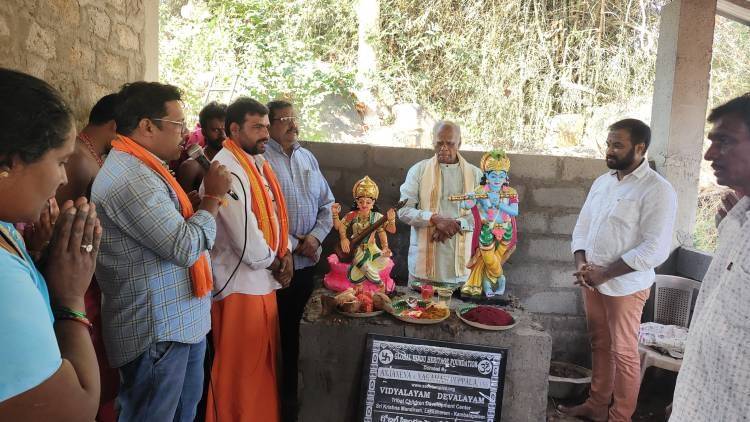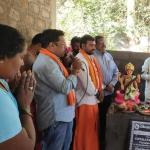[GHHF] Grama Devata Temples – why build in villages and what purpose do they serve to the community?
 Global Hindu Heritage Foundation was founded with a mission to preserve, propagate, and promote Sanatana Dharma to enrich the Hindu community and to spread the principles of dharma, which promote righteous conduct across generations. So far, we have either constructed about 75 small Temples or renovated old Temples in villages.
Global Hindu Heritage Foundation was founded with a mission to preserve, propagate, and promote Sanatana Dharma to enrich the Hindu community and to spread the principles of dharma, which promote righteous conduct across generations. So far, we have either constructed about 75 small Temples or renovated old Temples in villages.
Temples are the Center of the cultural and spiritual needs of Villagers.
For millennia, the Hindu temple has stood at the center of Indian civilization—not merely as a religious monument but as a cultural, educational, and social institution. In rural India, the village temple has functioned as a unifying space, blending art, architecture, ethics, and public life. Modern scholars such as Ananda K. Coomaraswamy, Stella Kramrisch, R. Nagaswamy, and George Michell have emphasized that temples symbolize the synthesis of spiritual and civic ideals in Indian society.
The Agni Purana proclaims that temple construction surpasses all other acts of charity or ritual. Even a small contribution toward building or repairing a temple yields immeasurable spiritual benefit:
“He who constructs a temple for Hari, Hara, or Devi obtains merit greater than that of a thousand sacrifices or ten million gifts.” (Agni Purana 90.1–3)
Small temples act as natural gathering spaces for villagers. They promote social cohesion through festivals, community meals, and shared maintenance activities. These spaces embody inclusiveness and cooperation, offering a sense of belonging that transcends social or economic divisions. Cultural geographers note that such public spaces contribute to collective identity and mutual trust.
In rapidly urbanizing, globalizing India, small village temples remain vital anchors of cultural identity. They preserve intangible heritage—language, oral traditions, folk art—while offering platforms for civic engagement. Scholars like Sri Aurobindo and Radhakrishnan emphasized that a culture's vitality depends on its capacity to translate spiritual ideals into community life. Small temples continue to fulfill that role by fostering beauty, solidarity, and a sense of rootedness.
The chanting of mantras produces sound frequencies that calm the nervous system. The fragrance of incense has therapeutic effects, while the act of pradakshina (circumambulation) promotes mindfulness and focus. Each sensory element—sound, sight, smell, touch—works together to purify the mind and uplift the spirit. Teertham, prostration, squatting, and reciting a mantra while doing pradakshina have their health and spiritual benefits.
Many scriptures extol the virtue of building Temples as one of the acts of preserving dharma, as a center for the transmission of knowledge, for the preservation of cultural heritage, and as a focal point for bringing villagers together under the powerful vibrations generated by regularly conducted temple activities.
In the village context, temples fostered community cohesion by bringing people together for festivals, shared meals, and voluntary service. They provided spaces for villagers to meet, deliberate, and collaborate on social issues, thereby reinforcing unity and collective responsibility.
Bhajan programs conducted in Temples generate vibrations that heal the body and serve to enrich the sacredness of the villages. Bhaja singing involves melodious devotional songs, often dedicated to deities and saints. Bhajans are not only an integral part of religious ceremonies but also serve as a means of connecting with the divine, fostering community, and enhancing personal well-being. In this article, we will explore the myriad benefits of incorporating daily Bhajan singing into your life. Singing purifies; it provides a safe space to release pent-up emotions such as grief, anger, or frustration. Bhajans encourage listeners to let go of negativity and embrace positive feelings associated with love and devotion.
Research has shown evidence that temples and other religious rituals contribute significantly to social cohesion, individual peace of mind, and a positive community environment. In Hinduism, temples are considered the earthly abode of the Divine, where spiritual energy flows continuously through sacred rituals, mantras, and offerings. For centuries, these holy spaces have served as a refuge for the soul, a place where daily stress fades, and only prayer remains.
Further, these Temples would deter the forceful or deceptive conversion to other religions. We have documented evidence to show how some of the different religions are converting village Hindus with false promises. They convert the whole village by promising either a place to play for their children or teaching good things without revealing their intent to promote their religion. GHHF has built or renovated a few Hindu Temples to prevent them from being exploited.
Your donations are appreciated;
By Zelle: ghhfusaorg@gmail.com
By PayPal: savetemples.org
By Check: Or you can send a check payable to GHHF, 14726 Harmony Lane, Frisco, TX 75035.
It is tax-deductible.
By Rupees: call 601-918-7111; +91 83096 43979





















 Urgent support needed for Bangladesh Hindus
Urgent support needed for Bangladesh Hindus 







